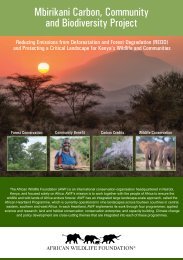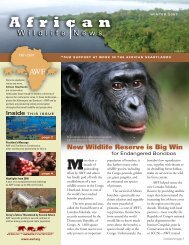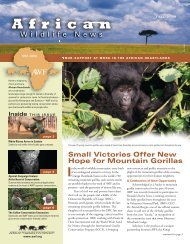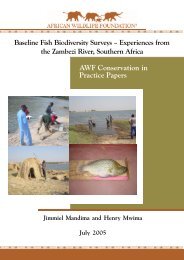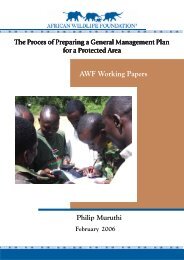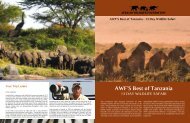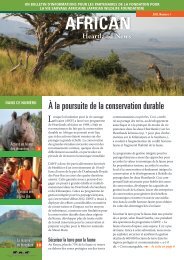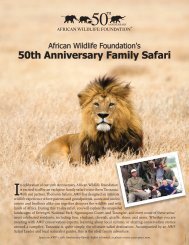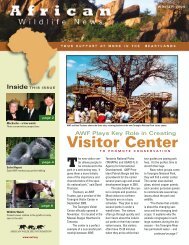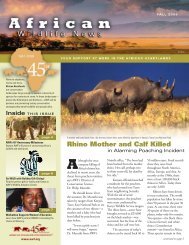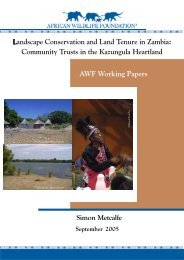The Killing Fields - African Wildlife
The Killing Fields - African Wildlife
The Killing Fields - African Wildlife
Create successful ePaper yourself
Turn your PDF publications into a flip-book with our unique Google optimized e-Paper software.
WINTER 2013Billy DodsonHome to elephants,rhinos, and more,<strong>African</strong> Heartlandsare conservation landscapes large enough tosustain a diversity of species for centuries to come.In these landscapes—places like Kilimanjaro andSamburu—AWF and its partners are pioneeringlasting conservation strategies that benefit wildlifeand people alike.Inside This IssueCraig R. Sholleypage 3AWF expands its work in Uganda to boosteco-tourism and enable conservation.page 6Meet the first class of AWF conservationmanagement trainees.page 8AWF Safari Sweepstakes winner gets afirsthand view of the Great Migration.In recent months, attempts to poach elephants have become increasingly brazen and high-tech.<strong>The</strong> <strong>Killing</strong> <strong>Fields</strong>Africa’s elephants are under assault, prompting AWF to expand its operationsBy Kathleen GarriganPoisoned pumpkins. Poison-tipped spears. Gunmen on horseback. Gunmen inhelicopters. Anti-tank mines.<strong>The</strong>se days if you’re an elephant poacher, the weapons of choice are as diverse as theyare profuse and are the instruments by which tens of thousands of the world’s largest landmammal are disappearing from Africa’s savannas and forests every year. Yet poaching alonedoesn’t explain the rapid disappearance of the continent’s elephants. Something is drivingthe poaching.That something is a voracious demand, mostly coming from Asia, for the pachyderm’steeth—its ivory.Even now, as elephant carcasses litter the <strong>African</strong> savanna, half a world away, ivorycraftsmen and women are busily spinning the “white gold” into jewelry, stamps, religiousfigurines, elaborate sculptures, and a seeming surfeit of other products sure to dazzle theivory buyer, who sees not the poached elephant but simply a beautiful object. <strong>The</strong> demandfor these objects is sky high—and growing.However, while demand for ivory may be inexhaustible, the supply isn’t. Currently, thenumber of elephants in Africa is somewhere between 400,000 and 600,000. “It’s estimated(continued on page 4)
2 <strong>African</strong> <strong>Wildlife</strong> News www.awf.orgBOARD OF TRUSTEESDavid ThomsonchairBenjamin W. Mkapavice-chairRobert E. KingtreasurerMyma Belo-OsagiesecretaryPatrick BerginRobert BerkeleyPayson ColemanLynn DolnickLisa FirestoneAdrian GardinerLarry GreenMarleen GroenPhilipp GutscheHeather Sturt HaagaMona HamiltonChristine HemrickWilliam E. JamesAdrian M. JayKristina JohnsonRahim KhanDenise KoopmansShana LaursenVictoria LeslieAnn K. LuskeyFestus G. MogaeRazan K. Al MubarakKristina PerssonStuart ScottAggie SkirballVeronica VarekovaCharles R. WallMaria Wilhelmtrustees emeritiE.U. Curtis BohlenJoan DonnerLeila S. GreenJohn H. HeminwayGeorge C. HixonDennis KellerHenry P. McIntosh IVSally PingreeStuart T. Saunders, Jr.<strong>African</strong> <strong>Wildlife</strong> Foundation1400 16th Street, N.W.Suite 120Washington, D.C. 20036Toll Free +1 888 494 5354Phone +1 202 939 3333Fax +1 202 939 3332email: africanwildlife@awf.orgAWF Conservation CentreNgong Road, KarenP.O. Box 310, 00502Nairobi, KenyaPhone +254 20 2765000Fax +254 20 2765030<strong>African</strong> <strong>Wildlife</strong> Newsis published four times a year.©2013 <strong>African</strong> <strong>Wildlife</strong> Foundationwww.awf.orgCFC# 11219Printed with soy-based ink on recycled paperAn Elephantine Intervention<strong>The</strong> job description is easy to write:“Wanted: Conservation Professionalfor <strong>African</strong> <strong>Wildlife</strong> Foundation. In additionto being passionate about Africa and its wildlife,must be:• A people person, able to relate to peoplefrom all walks of life;• A regional historian with an understanding of how past eventshave led to current circumstances;• A scientist who can apply conservation researchto the real world;• A creative thinker able to find new solutions tolong-standing problems;• An optimist who finds the potential for success in even themost seemingly intractable situations; and• A realist who understands when it might be timeto apply different methods.<strong>The</strong> faint of heart need not apply.”Sometimes I think that last point may be the most critical, for we all know thatconservation can be a challenging, and sometimes dispiriting, endeavor. You’ve hopefullyhad a chance to read our special supplement, “Rhinos in Peril,” which came with theprevious issue of <strong>African</strong> <strong>Wildlife</strong> News (see an update on page 5). Unfortunately, it is notonly rhino poaching but also elephant poaching that has been on the rise in Africa.Demand for elephant ivory has increased in the past couple of years, in part becauseof rising incomes in Asia. As you’ll read in our cover story, there are many criminalsthat are only too happy to slaughter defenseless elephants to satisfy this demand. AWFhas identified some new locations where we’ll direct additional funds, supplementingour ongoing work tosupport national parksIt takes a special kind of personto have the commitment,conviction, and courage totackle conservation in Africa.and communities in ourHeartlands.To be successful,though, we also needto ensure that Africahas sufficient qualifiedconservation professionals.As you can probablyguess, that tongue-in-cheek job description of mine was easy to write but has historicallybeen difficult to fill. AWF’s history began with support of the College of <strong>African</strong> <strong>Wildlife</strong>Management in Mweka, Tanzania. As Mweka College celebrates its 50 th anniversaryyear (see p. 7), we are going back to our capacity-building roots and launching a newconservation mentoring program. Meet our first class of conservation management traineeson p. 6.It takes a special kind of person to have the commitment, conviction, and courageto tackle conservation in Africa. But with your continued support, we’ll have a lastingimpact—not just for Africa’s rhinos and elephants, but for the entire continent.Patrick Bergin, Ph.D.Chief Executive OfficerJohn Butler
www.awf.org Winter 2013 3Where EastMeets WestAWF expands its work in UgandaBy Kathleen GarriganWinston Churchill once called Ugandathe “Pearl of Africa,” and indeed thecountry’s diversity of animals andlandscapes has earned it the verbal adornment.Here the East <strong>African</strong> savanna meets CentralAfrica’s lush forests, transforming the Ugandancanvas into a rich, overlapping tapestry ofecosystems that are home to some of theworld’s most celebrated species, from two of theworld’s five great apes—the mountain gorillaand chimpanzee—to lions, elephants, buffalo,and other iconic <strong>African</strong> wildlife.Situated on the East <strong>African</strong> plateau withits western border tucked into the AlbertineRift—the western half of East Africa’s greatrift—Uganda boasts abundant rainfall, consistentclimate, and extraordinary natural assets.“<strong>The</strong> centerpiece for conserving Uganda’s biodiversity, and thebasis for the tourism industry in the country, is the Albertine RiftValley,” says Kaddu Sebunya, AWF’s director for the Tourism forBiodiversity Program, a new project funded by the U.S. Agency forInternational Development (or USAID). “This area of Africa contains52 percent of all bird species and 39 percent of all mammal speciesfound on the continent and has more endemic species of plants andanimals than any other eco-region of Africa.”For close to a decade, AWF has worked with communities,wildlife authorities, and the private sector in and around Uganda’sBwindi Impenetrable National Park to protect the criticallyendangered mountain gorillas.AWF has embarked on a new program to boost Uganda’s eco-tourism industry while creating a foundationfor future conservation.Now, in recognition of Uganda’s other natural assets, AWFis embarking on a countrywide program to enhance economicgrowth and biodiversity conservation through tourism. Uganda’sNational Development Plan for 2010 – 2015 has recognizedtourism as a facilitator of economic growth and development.“In Uganda, rural poverty is rooted in a lack of economicopportunities and in the deterioration of natural resourcesessential to rural productive activities,” explains Sebunya. “Linkingtourism to biodiversity conservation and the well-being of localcommunities, and understanding how and where they overlap,unlocks many opportunities in the country.” nPhillip MuruthiAlejandro TawilCarnivores in the BackyardAWF conducts cross-border carnivore census to inform conservation measures in Kilimanjaro HeartlandBy Kathleen GarriganCarnivores across Africa are in decline as a result of habitat lossand fragmentation, as well as human–wildlife conflict. InAWF’s Kilimanjaro Heartland, which overlaps the Kenya–Tanzania border, lions, wild dogs, and other carnivores are estimatedto have declined by 70 percent in the last century. Last year, togain a better understanding of population trends and distribution,AWF assisted Kenya <strong>Wildlife</strong> Service and Tanzania National Parksin conducting the region’s first cross-border large-carnivore census.Preliminary results indicate hyenas are the most abundant carnivorein the ecosystem, followed by jackals and lions, and pose thegreatest threat to livestock. Lions were a close second. Informationprovided by the census will lead to fresh approaches for mitigatinghuman–predator conflict, supplementing AWF’s ongoing work withcommunities to protect wildlife. nContrary to popular beliefs, hyenas—not lions—on the Kenya–Tanzaniaborder are likely the greatest threat to livestock.
www.awf.org Winter 2013 5Billy DodsonIf poaching continues at current rates, the future does not look good for Africa’s elephants.Communities and wildlife authorities are only part of theequation when it comes to combatting poaching on the ground,however. Ultimately, the cooperation from both in apprehendingpoachers must be backed up by a judicial process that appropriatelypenalizes wildlife criminals. Recent—and rare—elephant poachingsoutside of Manyara Ranch in northern Tanzania underscore this.After a number of elephants were poached, communities aroundLike the “conflict diamonds”that fueled civil wars, ivory hasbecome the new blood diamond.Rhino Poaching atAll-Time High—AgainYear-end rhino poaching numbers are causefor alarmA total of 668 rhinos were poached in 2012 in SouthAfrica, the <strong>African</strong> country with the largest rhinopopulation. This is a horrific increase over 2011’stotal, which at the time was a new high of 448. AWFcontinues to monitor the situation and make strategicinvestments to ensure the long-term survival ofAfrica’s rhinos. Support our effort at: awf.org/donatethe ranch helped AWF and authorities to identify the culprits.However, the poachers were released immediately on bail and,according to AWF’s Maasai Steppe Heartland director, poachingpenalties remain insubstantial in the district. Now that AWF isgetting the cooperation from communities, ensuring penalties andsentences handed down by the courts are steep enough to dissuadeexisting and future poachers is an area in which AWF will turn itsattention.Such measures may have come too late for Bouba N’Djida’selephants last year—but AWF is ensuring it won’t be too late forthe rest of Cameroon’s, and Africa’s, elephants. nFederico Veronesi/www.federicoveronesi.com



